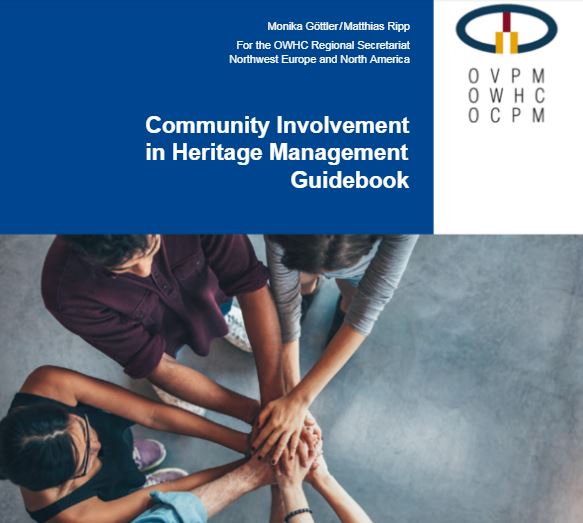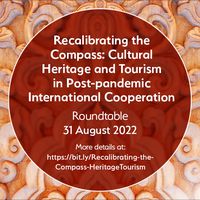Guidebook: Community Involvement in Heritage Management
 The Organization of World Heritage Cities (OWHC) and the City of Regensburg, in partnership with the joint EU / Council of Europe project COMUS and the Eurocities network, have recently published Community Involvement in Heritage Management Guidebook. The 72-page publication highlights community involvement as an important approach in preservation, management and promotion of urban heritage, and introduces 18 urban projects from Europe and North America.
The Guidebook, written by Monika Göttler and Matthias Ripp, draws on examples from the OWHC Regional Conference “Heritage and Community Involvement” held in in 2016, as well as others from OWHC cities and the EU-funded Culture for Cities and Regions project, managed by Eurocities and KEA. Among others, a new tool in heritage management evaluation, the Communication Model for Built heritage assets (COBA), is presented.
Evidence presented in the publication shows how local cultural and heritage institutions are increasingly geared towards a participatory culture - including co-creation - in order to provide content that fits the audiences’ needs and includes them in the management and protection of their heritage. Indeed, new approaches intend to involve local communities in the protection and preservation of urban heritage, increasing their responsibilities and feeling of ownership. Community involvement can be a driver for change.
Cities play an important role in encouraging cultural organisations and communities to collaborate, share resources, group together and explore innovative forms of partnerships. Experiences from cities reveal that it is not just important to ask locals for their ideas, but to shape programmes with them and involve them directly. Co-creation can be an important part of this, as citizens today are demanding more direct participation. Cities’ cultural administrations can facilitate this process by acting as brokers to make local cultural organisations and different audience groups meet and discuss how to work together.
Local cultural heritage represents a vital aspect of urban life, and it is the cities’ role to make sure that it remains attractive to diverse audiences. Cultural heritage is a powerful tool that contributes to building cities’ identities and increasing their attractiveness, and, when well-managed, heritage sites can drive economic activities and become hubs for creativity, culture, community interaction and social integration.
Community Involvement in Heritage Management Guidebook is available as a free download at https://www.ovpm.org/sites/ovpm/files/documents/final_owhc_guidebook_2017_0.pdf
The Organization of World Heritage Cities (OWHC) and the City of Regensburg, in partnership with the joint EU / Council of Europe project COMUS and the Eurocities network, have recently published Community Involvement in Heritage Management Guidebook. The 72-page publication highlights community involvement as an important approach in preservation, management and promotion of urban heritage, and introduces 18 urban projects from Europe and North America.
The Guidebook, written by Monika Göttler and Matthias Ripp, draws on examples from the OWHC Regional Conference “Heritage and Community Involvement” held in in 2016, as well as others from OWHC cities and the EU-funded Culture for Cities and Regions project, managed by Eurocities and KEA. Among others, a new tool in heritage management evaluation, the Communication Model for Built heritage assets (COBA), is presented.
Evidence presented in the publication shows how local cultural and heritage institutions are increasingly geared towards a participatory culture - including co-creation - in order to provide content that fits the audiences’ needs and includes them in the management and protection of their heritage. Indeed, new approaches intend to involve local communities in the protection and preservation of urban heritage, increasing their responsibilities and feeling of ownership. Community involvement can be a driver for change.
Cities play an important role in encouraging cultural organisations and communities to collaborate, share resources, group together and explore innovative forms of partnerships. Experiences from cities reveal that it is not just important to ask locals for their ideas, but to shape programmes with them and involve them directly. Co-creation can be an important part of this, as citizens today are demanding more direct participation. Cities’ cultural administrations can facilitate this process by acting as brokers to make local cultural organisations and different audience groups meet and discuss how to work together.
Local cultural heritage represents a vital aspect of urban life, and it is the cities’ role to make sure that it remains attractive to diverse audiences. Cultural heritage is a powerful tool that contributes to building cities’ identities and increasing their attractiveness, and, when well-managed, heritage sites can drive economic activities and become hubs for creativity, culture, community interaction and social integration.
Community Involvement in Heritage Management Guidebook is available as a free download at https://www.ovpm.org/sites/ovpm/files/documents/final_owhc_guidebook_2017_0.pdf
Source: http://www.cultureforcitiesandregions.eu/culture/case_studies/Save-your-heritage-Community-Involvement-in-Heritage-Management-a-guidebook-WSWE-AQYE3B
Similar content
from - to
31 Aug 2022 - 31 Aug 2022
from - to
22 Jun 2020 - 30 Jun 2020
24 Feb 2016 - 26 Feb 2016



